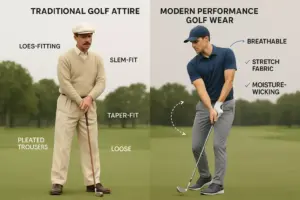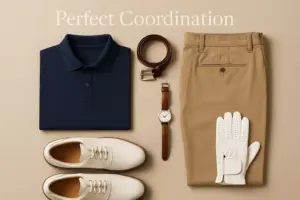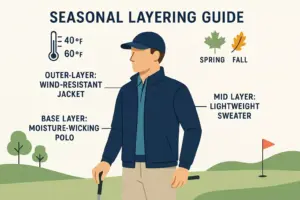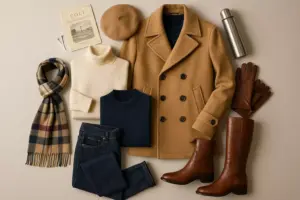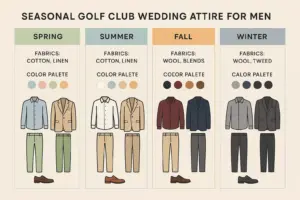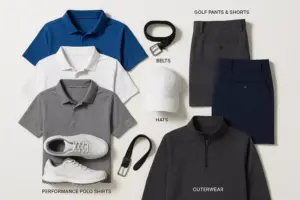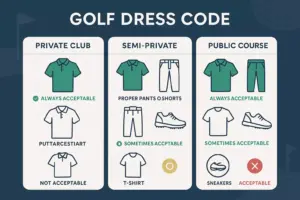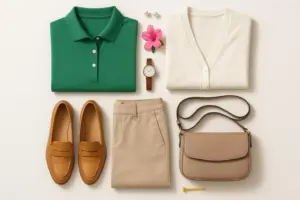Your Fall Golf Wardrobe Sorted: The Best Cold-Weather Attire for Women
When the autumn leaves start falling and morning frost kisses the fairways, many female golfers face a common dilemma: how to stay warm without sacrificing style or performance on the course. The crisp fall air that makes for perfect golf weather can quickly turn into a chilly challenge that leaves you reaching for bulky sweaters that restrict your swing or lightweight layers that leave you shivering over crucial putts.
The secret to conquering cold-weather golf isn’t about piling on more clothes—it’s about choosing the right clothes. Smart layering, moisture-wicking fabrics, and strategic accessories can transform your fall golf experience from an endurance test into pure enjoyment. Whether you’re a weekend warrior or a serious competitor, mastering your cold-weather golf wardrobe will keep you comfortable, confident, and playing your best game as temperatures drop.
Key Takeaways

- Layer strategically with moisture-wicking base layers, insulating mid-layers, and weather-resistant outer shells for optimal temperature control
- Invest in quality materials like merino wool, synthetic blends, and technical fabrics that move with your swing while providing warmth
- Don’t forget extremities—proper gloves, hats, and footwear are crucial for maintaining grip, focus, and stability in cold conditions
- Choose versatile pieces that can be easily added or removed as weather conditions change throughout your round
- Prioritize fit and flexibility to ensure your cold-weather gear enhances rather than hinders your golf performance
Understanding Cold-Weather Golf Challenges
Playing golf in cooler temperatures presents unique challenges that go beyond simply feeling cold. Temperature regulation becomes crucial as your body generates heat during the swing but cools down quickly between shots. The key is maintaining consistent body temperature while preserving the flexibility and range of motion essential for a proper golf swing.
Cold weather affects more than just comfort—it impacts ball flight, club performance, and mental focus. When your hands are cold, grip pressure changes, affecting club control. Stiff muscles from cold temperatures can reduce swing speed and accuracy. Understanding these challenges helps you choose clothing that addresses each issue effectively.
The Science of Staying Warm
Your body loses heat through several mechanisms: conduction (direct contact with cold surfaces), convection (air movement), radiation (heat loss to the environment), and evaporation (moisture from perspiration). Effective cold-weather golf attire addresses each of these heat loss methods through strategic fabric choices and design features.
Moisture management becomes even more critical in cold weather. Wet skin loses heat 25 times faster than dry skin, making moisture-wicking fabrics essential for maintaining warmth and comfort throughout your round.
Essential Base Layers: Your Foundation for Warmth
The base layer serves as your first line of defense against cold weather and forms the foundation of any effective layering system. This layer sits directly against your skin and should prioritize moisture management and thermal regulation above all else.
Material Matters: Choosing the Right Fabric
Merino wool stands out as the gold standard for golf base layers. Unlike traditional wool, merino fibers are incredibly fine and soft, providing excellent temperature regulation without the itchy feeling. Merino wool naturally resists odors, wicks moisture effectively, and maintains insulating properties even when damp.
Synthetic blends offer another excellent option, particularly those incorporating polyester and elastane. These materials excel at moisture-wicking and typically dry faster than natural fibers. Look for fabrics with four-way stretch to ensure unrestricted movement during your swing.
Top Base Layer Recommendations
| Material Type | Benefits | Best For |
|---|---|---|
| Merino Wool | Natural odor resistance, temperature regulation | Multi-round tournaments, varying conditions |
| Synthetic Blends | Quick-drying, durability, cost-effective | Frequent play, high-moisture situations |
| Bamboo Blends | Eco-friendly, naturally antimicrobial | Sensitive skin, sustainability-conscious golfers |
Fit considerations are crucial for base layers. The garment should feel snug but not restrictive, allowing for full range of motion while maintaining contact with your skin for effective moisture transfer. Avoid cotton at all costs—it retains moisture and loses insulating properties when wet.
Mid-Layers: Insulation That Moves With You
The mid-layer provides the bulk of your insulation while allowing moisture to pass through to outer layers. This layer should trap warm air close to your body while maintaining breathability and flexibility for unrestricted golf swings.
Fleece and Synthetic Options
Technical fleece has evolved significantly from the bulky versions of the past. Modern golf-specific fleece incorporates stretch panels in key areas like the shoulders and underarms to maintain swing flexibility. Look for fleeces with flat-seam construction to prevent chafing during the repetitive motions of golf.
Synthetic insulation offers excellent warmth-to-weight ratios and performs well in damp conditions. Materials like PrimaLoft and Thinsulate provide substantial warmth without bulk, making them ideal for golf applications where mobility is paramount.
Wool and Natural Fiber Mid-Layers
Wool sweaters specifically designed for golf combine traditional style with modern performance features. Look for pieces that incorporate stretch fibers and moisture-wicking treatments. Lightweight wool cardigans or zip-up styles offer versatility for changing conditions throughout your round.
Cashmere blends provide luxury and warmth but require more care and may not offer the moisture management of technical fabrics. Reserve these for dry, consistently cool conditions where performance demands are moderate.
Outer Layers: Weather Protection Without Restriction
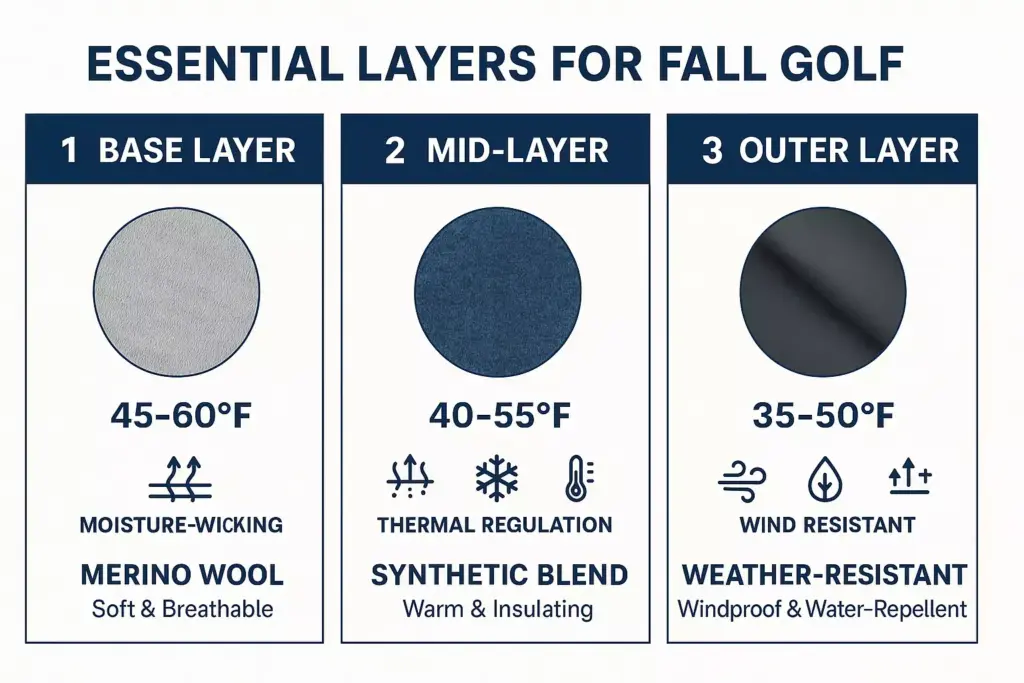
Your outer layer serves as the primary barrier against wind, rain, and cold air while allowing moisture vapor to escape from inner layers. Golf-specific outer layers must balance weather protection with swing freedom—a challenge that separates quality golf outerwear from general outdoor clothing.
Wind-Resistant Options
Windproof fabrics can make a significant difference in perceived temperature. A 10-mph wind can make 50°F feel like 40°F. Look for outer layers with DWR (Durable Water Repellent) treatments that shed light moisture while maintaining breathability.
Soft shell jackets offer excellent wind protection with superior stretch and breathability compared to hard shell alternatives. These jackets typically feature a weather-resistant exterior with a soft, comfortable interior that moves naturally with your body.
Waterproof and Breathable Solutions
Gore-Tex and similar membranes provide complete waterproof protection while allowing moisture vapor to escape. For golf applications, look for three-layer constructions that eliminate the need for separate linings and reduce bulk.
Packable rain gear serves as emergency protection that can be easily stored in your golf bag. Modern packable jackets weigh less than a pound while providing full waterproof protection when unexpected weather strikes.
Accessories That Make the Difference
Cold-weather golf accessories often determine the difference between an enjoyable round and a miserable experience. Extremities lose heat quickly and directly impact your ability to maintain proper grip and focus throughout your round.
Gloves: Maintaining Grip and Warmth
Cold-weather golf gloves must balance warmth with the tactile feedback essential for proper club control. Thermal golf gloves typically feature synthetic insulation in the back of the hand while maintaining thin, grippy palms for club feel.
Glove layering systems allow for adaptability as conditions change. Thin liner gloves under regular golf gloves provide extra warmth while maintaining the option to remove the outer layer for putting or approach shots requiring maximum feel.
Headwear for Comfort and Performance
Thermal beanies designed for golf feature low-profile designs that won’t interfere with your swing or hat fit. Look for styles with moisture-wicking linings and wind-resistant exteriors.
Ear warmers and headbands offer targeted protection while maintaining full peripheral vision and hearing—crucial for golf safety and course awareness.
Footwear Solutions
Thermal socks made from merino wool or synthetic blends prevent cold feet that can affect balance and comfort. Avoid cotton socks that retain moisture and lose insulating properties.
Golf shoe covers or winter golf shoes with insulation and improved traction help maintain stability on potentially slippery surfaces while keeping feet warm and dry.
🏌️♀️ Fall Golf Wardrobe Builder
Get personalized clothing recommendations for your golf round
Fabric Technologies to Know
Understanding fabric technologies empowers you to make informed decisions when building your cold-weather golf wardrobe. Modern textiles incorporate sophisticated features that address the specific challenges of playing golf in cooler conditions.
Moisture-Wicking Technologies
Capillary action fabrics use fiber structure to pull moisture away from skin and spread it across the fabric surface for faster evaporation. Polyester microfibers excel at this process, while merino wool achieves similar results through its natural fiber structure.
Chemical treatments like Coolmax and Dri-FIT enhance moisture management in synthetic fabrics. These treatments create hydrophobic surfaces that repel moisture while maintaining fabric breathability.
Thermal Regulation Features
Phase change materials (PCMs) represent cutting-edge thermal regulation technology. These materials absorb excess heat when you’re warm and release stored heat when temperatures drop, maintaining consistent comfort levels.
Zoned insulation places different insulation levels in various garment areas. Core areas receive maximum insulation while high-movement zones like shoulders and underarms feature reduced insulation or stretch panels for unrestricted motion.
Building Your Layering System
Creating an effective layering system requires understanding how different pieces work together to provide comprehensive climate control. The key lies in selecting pieces that complement each other while offering flexibility for changing conditions.
The Three-Layer Principle
Layer 1 (Base): Manages moisture and provides initial thermal regulation
Layer 2 (Mid): Provides primary insulation and warmth
Layer 3 (Outer): Protects against wind, rain, and external elements
This system allows for easy adjustment as weather conditions change throughout your round. You can add or remove layers without compromising the effectiveness of remaining pieces.
Mix and Match Strategies
Versatile pieces that work across multiple temperature ranges maximize your wardrobe investment. A lightweight merino wool base layer performs well from 35-60°F when paired with appropriate outer layers.
Color coordination ensures your layered look remains polished and course-appropriate. Neutral base colors like navy, gray, and white provide flexibility for mixing different pieces while maintaining a cohesive appearance.
Seasonal Transition Pieces
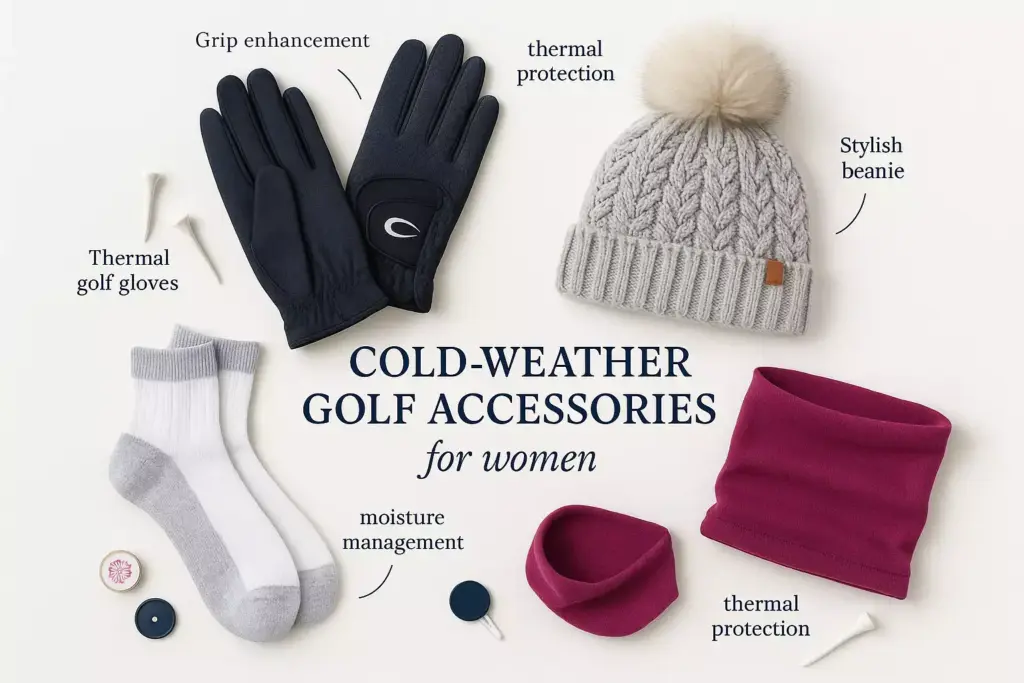
Transitional garments bridge the gap between summer and winter golf wear, providing versatility for unpredictable fall weather. These pieces typically feature moderate insulation with high breathability for changing conditions.
Convertible Options
Zip-off sleeves on base layers allow quick adaptation from long to short sleeves as temperatures rise throughout your round. Removable hoods on outer layers provide weather protection options without permanent bulk.
Reversible garments offer two looks in one piece while providing different performance characteristics on each side. Some feature wind-resistant exteriors with soft, comfortable interiors.
Investment Pieces Worth Considering
High-quality wool sweaters with technical enhancements serve double duty on and off the course. Look for pieces with stretch panels, moisture-wicking treatments, and odor resistance for maximum versatility.
Premium base layers in merino wool or high-tech synthetics provide the foundation for multiple outfit combinations while offering superior comfort and performance longevity.
Care and Maintenance Tips
Proper care extends the life and performance of your cold-weather golf attire while maintaining the technical features that make these garments effective. Technical fabrics often require specific care procedures to preserve their performance characteristics.
Washing Guidelines
Moisture-wicking fabrics should be washed in cold water with technical detergents that don’t leave residue. Avoid fabric softeners which can clog fibers and reduce moisture-wicking effectiveness.
Merino wool items benefit from gentle cycles and wool-specific detergents. Air drying preserves fiber integrity and prevents shrinkage that can affect fit and performance.
Storage Solutions
Proper storage prevents damage and maintains garment shape. Hanging structured pieces like jackets and sweaters prevents compression damage to insulation. Folding base layers and accessories saves space while preventing stretching.
Cedar blocks or lavender sachets provide natural moth protection for wool items while maintaining fresh scents. Avoid plastic storage bags that can trap moisture and promote mildew growth.
Budget-Friendly Options
Building an effective cold-weather golf wardrobe doesn’t require breaking the bank. Strategic shopping and smart prioritization help you acquire quality pieces within any budget.
Essential vs. Nice-to-Have
Priority purchases should focus on base layers and gloves—items that directly contact your skin and most significantly impact comfort. Quality base layers provide the foundation for any layering system and represent the best cost-per-wear value.
Secondary purchases include mid-layers and specialized accessories. These items enhance comfort but aren’t absolutely essential for playing in cold weather.
Shopping Strategies
End-of-season sales offer significant savings on cold-weather golf attire. Late winter and early spring clearances provide opportunities to acquire premium pieces at reduced prices for the following season.
Multi-sport pieces from outdoor recreation brands often provide similar performance to golf-specific items at lower prices. Ensure pieces offer adequate range of motion for golf swings before purchasing.
Conclusion
Mastering your fall golf wardrobe transforms cold-weather rounds from endurance tests into enjoyable experiences. The key lies in understanding layering principles, fabric technologies, and strategic piece selection that prioritizes both performance and comfort.
Smart layering with moisture-wicking base layers, insulating mid-layers, and weather-resistant outer shells provides the flexibility and protection needed for changing fall conditions. Quality accessories like thermal gloves, warm headwear, and appropriate footwear complete the system while addressing often-overlooked comfort factors.
Investment in versatile, high-quality pieces pays dividends through extended playing seasons and improved on-course performance. Focus on foundational items like premium base layers and essential accessories before expanding to specialized pieces.
Your Next Steps
- Assess your current wardrobe and identify gaps in your layering system
- Prioritize base layer upgrades for immediate comfort improvements
- Invest in quality gloves and headwear to address extremity warmth
- Build your collection gradually with versatile pieces that work across multiple conditions
- Test your complete system during practice rounds before important tournaments
With the right cold-weather golf attire, you’ll maintain consistent performance and genuine enjoyment throughout the fall season and beyond. Proper preparation ensures that dropping temperatures never force you to choose between comfort and playing the game you love.

